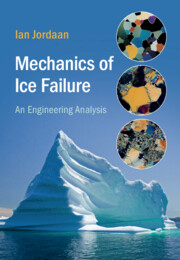
-
Select format
-
- Publisher:
- Cambridge University Press
- Publication date:
- February 2023
- March 2023
- ISBN:
- 9781108674454
- 9781108481601
- Dimensions:
- (244 x 170 mm)
- Weight & Pages:
- 0.6kg, 244 Pages
- Dimensions:
- Weight & Pages:
You may already have access via personal or institutional login
Book description
Featuring real-world examples and practical methodology, this rigorous text explores time dependence in the mechanics of ice. Emphasizing use of full scale data, and implementing risk-based design methods, mechanical theory is combined with design and modelling. Readers will gain understanding of fundamental concepts and modern advances of ice mechanics and ice failure processes, analysis of field data, and use of probabilistic design methods, with applications to the interaction of ships and offshore structures with thick ice features or icebergs. The book highlights the use of viscoelastic theory, including nonlinearity with stress and the effects of microstructural change, in the mechanics of ice failure and fracture. The methods of design focus on risk analysis, with emphasis on rational limit-state principles and safety. Full discussion of historical discoveries and modern advances – including Hans Island, Molikpak, and others – support up-to-date methods and models to make this an ideal resource for designers and researchers.
Contents
Metrics
Altmetric attention score
Full text views
Full text views help Loading metrics...
Loading metrics...
* Views captured on Cambridge Core between #date#. This data will be updated every 24 hours.
Usage data cannot currently be displayed.
Accessibility standard: Unknown
Why this information is here
This section outlines the accessibility features of this content - including support for screen readers, full keyboard navigation and high-contrast display options. This may not be relevant for you.
Accessibility Information
Accessibility compliance for the PDF of this book is currently unknown and may be updated in the future.

